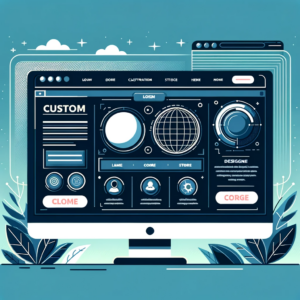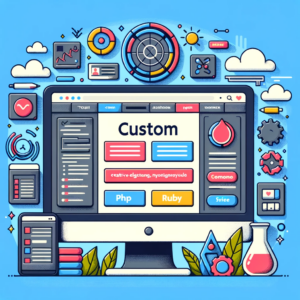The Need for Customization in the Digital World
Today, the marketplace is incredibly saturated, and consumers have limitless options. What sets a business apart in such a competitive environment is customization. Offering a bespoke experience, be it in products, services, or web interfaces, has become not just an advantage but a necessity. A website is often the first point of contact between a business and a potential customer, making it a crucial component of business strategy. Custom web development enables companies to offer unique, focused experiences that align perfectly with brand identity and business goals. At Wolfies Creative, great custom web development is the backbone of a unique and thriving business.

The Evolution of Custom Web Development
The journey of custom web development has been transformative. The early internet era was rife with challenges—developers had limited tools, and even simple tasks required extensive coding. Flash forward to today, and the landscape is drastically different. With the advent of sophisticated languages, frameworks, and development tools, custom web development has become more efficient and versatile, allowing for highly interactive and dynamic websites.
What Custom Web Development Really Means
Custom web development is not about reinventing the wheel; it’s about creating a unique wheel that perfectly fits your vehicle. It involves tailoring every element of a website to align seamlessly with the brand’s objectives, needs, and aspirations. This ranges from the aesthetic design elements to the functional aspects like user interface and experience (UI/UX), search engine optimization (SEO), and back-end functionalities.
Benefits of Custom Web Development
Uniqueness and Brand Identity
In a digital landscape filled with cookie-cutter websites, standing out is essential. Custom web development enables businesses to build a unique brand identity and offers users a unique experience that can’t be replicated by competitors. This level of uniqueness often translates to increased brand loyalty and customer retention.

Scalability
One of the critical advantages of custom web development is scalability. Pre-made templates often have limitations in terms of features and scalability. In contrast, custom websites can grow as your business does, offering the ability to incorporate additional features and functionalities as needed, without having to migrate to a different platform or framework.
Security
Security is a significant concern in the online world. Custom web development allows businesses to implement specialized security measures tailored to their specific needs. This custom security approach can provide robust protection against a wide variety of threats, from data breaches to DDoS attacks.
Full Control
A custom website is like a tailored suit; you get to choose everything from the fabric to the buttons and the thread. This translates to full control over the website’s back-end, allowing for any range of customizations—be it complex workflows, user roles, or custom reporting.
Enhanced User Experience
Custom-built websites enable you to create user pathways, guiding visitors through the site in a manner that is most conducive to your business objectives. Effective user pathway planning can lead to better user engagement, increased conversion rates, and improved customer satisfaction.
How Custom Web Development Works
Steps in Custom Web Development
Creating a custom website is a multi-step process that requires a lot of planning, execution, and testing.
Requirement Analysis
This is the foundational step where businesses need to define what they want from the website. This includes functionality, main features, target audience, and business goals. The more detailed the requirement analysis, the smoother the subsequent steps will be.

Design
Once requirements are laid down, designers come into play. They create wireframes, design elements, and the user interface, taking into consideration both aesthetics and usability. The designs are usually iterated upon until they align perfectly with what the business needs.
Development
This is where the actual building happens. Developers use various languages and frameworks to bring the design to life, ensuring that the site’s front-end and back-end work in harmony.
Testing
Testing is not a one-off step but is often parallel to development. Continuous testing ensures that bugs are identified and fixed in real-time, making for a much more stable end product.
Deployment
Once the site is tested, it’s time to launch. But deployment is not just about uploading files to a server; it also involves database setup, configuration settings, and potentially even server scaling.
Maintenance
After deployment, the website enters the maintenance phase where ongoing work like updates, bug fixes, and new features are handled.
In-house vs. Outsourced Development
The debate between keeping development in-house or outsourcing it is evergreen. Both have their own merits and demerits. In-house development ensures closer collaboration and better control but is often more expensive. Outsourcing is cost-effective and taps into a global talent pool but may present challenges in communication and quality control.
Technologies Used in Custom Web Development
Front-end Technologies
The front-end of the website is where user interaction happens, and hence it needs to be immaculate.
HTML, CSS, JavaScript
These are the staples of front-end development, responsible for layout, styling, and interactivity, respectively.
Frameworks
Frameworks like AngularJS, ReactJS, and Vue.js have risen in popularity, allowing developers to build dynamic, single-page applications with ease.
Back-end Technologies
The back-end is the backbone of any website, handling the server and the database, making sure everything on the front-end actually works.

Programming Languages
Popular back-end languages include Python, Ruby, PHP, and Node.js. Each has its own set of frameworks that make back-end development easier and more efficient.
Databases
Whether it’s SQL databases like MySQL and PostgreSQL or NoSQL databases like MongoDB, the choice of database can significantly impact website performance and scalability.
Cost Factors
Development Time
Time is money, and this holds true in web development. Complex sites with numerous features naturally require more time, hence higher costs.
Complexity
The complexity of the website doesn’t just affect development time but also the expertise required, influencing the overall cost.
Talent
Whether you’re hiring in-house or outsourcing, the skill level of the development team will be a significant cost factor.
Ongoing Costs
The initial development is just the tip of the iceberg. Websites require continuous upkeep, and these ongoing costs can include hosting, maintenance, and periodic updates and redesigns.

Risks and How to Mitigate Them
Budget Overflows
Custom web development projects can easily exceed budgets due to unforeseen complexities and scope changes. An effective way to mitigate this risk is through meticulous planning and setting aside a contingency budget.
Time Delays
Timelines can often be extended due to various issues like technical roadblocks or changes in requirements. Maintaining a buffer in the timeline and keeping stakeholders informed can help manage delays better.
Technical Issues
From server crashes to database errors, technical issues are unpredictable. Ensuring best practices, continuous testing, and having a skilled development team can considerably reduce this risk.
The Future of Custom Web Development
Trends
Custom web development is continuously evolving. Technologies like Artificial Intelligence, Virtual Reality, and blockchain are making headway into the industry, paving the path for more interactive and secure websites.
How to Stay Updated
With the tech world being so volatile, staying updated is crucial. Regularly following industry news, participating in webinars, and upskilling are excellent ways to stay ahead of the curve.
Conclusion
The world of custom web development is complex yet incredibly rewarding. With the right planning, a skilled team, and an eye for detail, your business can benefit substantially from a custom website. It offers unparalleled advantages, from brand uniqueness and customer engagement to scalability and robust security measures.

FAQs
- What is custom web development? Custom web development involves building a website from scratch, tailored to the specific needs and goals of a business.
- Is custom web development expensive? Costs can vary widely depending on the complexity, features, and the team involved in the development.
- How long does it take to build a custom website? The time required can range from a few weeks for simple sites to several months for complex web applications.
- Is a custom website better than using a template? While templates offer quick and relatively inexpensive solutions, custom websites offer much more flexibility, scalability, and uniqueness.
- How do I choose the right technology for my custom website? The choice of technology can greatly impact the functionality and scalability of your site. Consulting with experienced professionals can provide valuable insights.






